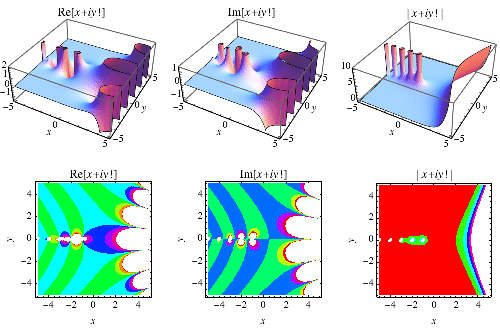階乘 對於正整數
定義為
|
(1)
|
因此,例如,。較舊的階乘記號寫作
(Mellin 1909; Lewin 1958, p. 19; Dudeney 1970; Gardner 1978; Conway and Guy 1996)。
特殊情況 被定義為值
,這與恰好一個排列零個物件的組合解釋一致(即,零個元素的排列只有一個,即空集
)。
階乘在 Wolfram 語言中實現為階乘[n] 或 n!。
三角形數 可以被看作是階乘
的加法模擬。階乘和三角形數之間的另一個關係由以下恆等式給出
 |
(2)
|
(K. MacMillan,私人通訊,1 月 21 日,2008 年)。
階乘 給出了
個物件可以排列的方式的數量。例如,
,因為
的六種可能的排列是
、
、
、
、
、
。對於
、1、2、...,前幾個階乘是 1、1、2、6、24、120、... (OEIS A000142)。
對於 、1、...,
中的位數是 1、7、158、2568、35660、456574、5565709、65657060、... (OEIS A061010)。
可以定義階乘的推廣,例如雙階乘 和多階乘
。但是請注意,這些不等於巢狀階乘
、
等。
對於 、2、...,
的前幾個值是 1、2、720、620448401733239439360000、... (Eureka 1974; OEIS A000197)。
中的位數是 1、1、3、24、199、1747、... (OEIS A063979)。
當 變大時,階乘開始出現尾隨零。要計算
的尾隨零的數量
,請使用
 |
(3)
|
其中
|
(4)
|
且 是向下取整函式 (Gardner 1978, p. 63; Ogilvy and Anderson 1988, pp. 112-114)。對於
、2、...,尾隨零的數量是 0、0、0、0、1、1、1、1、1、2、2、2、2、2、3、3、... (OEIS A027868)。這是勒讓德在 1808 年首次發現的一般結果的特殊應用:整除
的素數
的最大冪是
 |
(5)
|
(Landau 1974, pp. 75-76; Honsberger 1976; Hardy and Wright 1979, pp. 342; Ribenboim 1989; Ingham 1990, p. 20; Graham et al. 1994; Vardi 1991; Hardy 1999, pp. 18 and 21; Havil 2003, p. 165; Boros and Moll 2004, p. 5)。這可以在 Wolfram 語言中實現為
HighestPower[p_?PrimeQ, n_] :=
Sum[Floor[n/p^k], {k, Floor[Log[p,n]]}]
|
(6)
|
其中 是
在
進位制下的數字和 (Boros and Moll 2004, p. 6)。這可以在 Wolfram 語言中實現為
HighestPower2[p_Integer?PrimeQ, n_] :=
(n - Total[IntegerDigits[n, p]])/(p - 1)
因此,正如勒讓德所示,
|
(7)
|
(Havil 2003, p. 165)。
設 為
中的最後一個非零數字,則前幾個值是 2、6、4、2、2、4、2、8、8、8、6、8、... (OEIS A008904)。Kakutani (1967) 研究了這個序列,他表明這個序列是“5-自動的”,大致意思是存在一個有限自動機,當給定
在 5 進位制下的數字時,它將最終進入一個狀態,該狀態的輸出對映指定
。數字的精確分佈由此結果得出。
 |
透過注意到
|
(8)
|
|
(9)
|
這定義了所有復數值 的
,除非
是負整數,在這種情況下,
等於復無窮大。
雖然高斯 (G1) 引入了記號
|
(10)
|
但在勒讓德引入伽瑪記號後,此記號隨後被棄用 (Edwards 2001, p. 8)。
使用伽瑪函式的恆等式,(半整數值)的值可以顯式寫出
|
(11)
| |||
|
(12)
| |||
|
(13)
| |||
|
(14)
|
其中 是雙階乘。
對於整數 和
,且
,
|
(15)
|
的對數經常遇到
|
(16)
| |||
![1/2ln[(piz)/(sin(piz))]-1/2ln((1+z)/(1-z))+(1-gamma)z-sum_(n=1)^(infty)[zeta(2n+1)-1](z^(2n+1))/(2n+1)](/images/equations/Factorial/Inline74.svg) |
(17)
| ||
|
(18)
| |||
|
(19)
| |||
|
(20)
|
其中 是尤拉-馬歇羅尼常數,
是黎曼 zeta 函式,而
是多伽瑪函式。
它也由極限給出
|
(21)
| |||
|
(22)
| |||
|
(23)
| |||
|
(24)
|
其中 是波赫哈默爾符號。
其中 是尤拉-馬歇羅尼常數,
是黎曼 zeta 函式,而
是多伽瑪函式。階乘可以展開為級數
|
(25)
|
(OEIS A001163 和 A001164)。斯特林級數給出了 的級數展開
|
(26)
| |||
|
(27)
|
(OEIS A046968 和 A046969),其中 是伯努利數。
一般來說,冪乘積序列 (Mudge 1997) 由 給出。
的前幾項是 2、5、37、577、14401、518401、... (OEIS A020549),並且對於
、2、3、4、5、9、10、11、13、24、65、76、...,
是素數 (OEIS A046029)。
的前幾項是 0、3、35、575、14399、518399、... (OEIS A046032),但
僅對於
是素數,因為對於
,
。
的前幾項是 0、7、215、13823、1727999、... (OEIS A046033),而
的前幾項是 2、9、217、13825、1728001、... (OEIS A019514)。
前幾個數 ,使得其數字的階乘之和等於素數計數函式
是 6500、6501、6510、6511、6521、12066、50372、... (OEIS A049529)。此序列是有限的,最大項是
。
滿足以下條件的數 被稱為威爾遜素數。
|
(28)
|
被稱為威爾遜素數。
|
(29)
|
僅已知三對這樣的數:(5, 4), (11, 5), (71, 7)。Erdős 猜想這僅有的三個這樣的對 (Guy 1994, p. 193)。